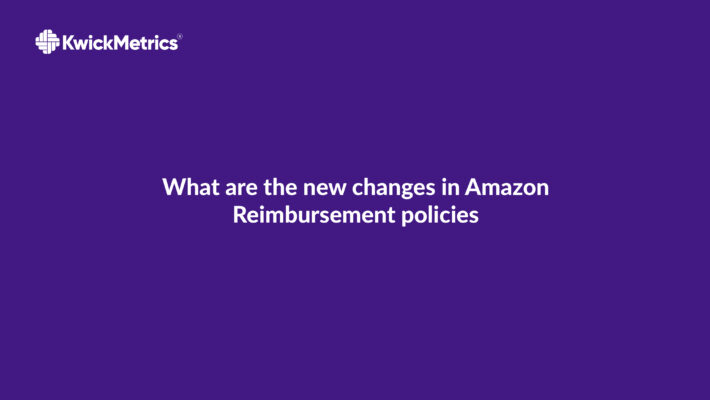Amazon Inventory Reports: Your Key to E-Commerce Success

Table of Contents
- Understanding Amazon Inventory Reports
- Types of Amazon Inventory Reports
- Navigating Seasonal Variations with Amazon Inventory Reports
- Try Our KwickMetrics - One Tool with Multiple Solutions!
- Competing in the Amazon Marketplace Using Inventory Reports
- Reducing Storage and Fulfilment Costs with Amazon Inventory Reports
- Overcoming Challenges in Amazon Inventory Management with Reports
- Boost Your Sales With KwickMetrics
- FAQs in Relation to Amazon Inventory Reports
- Conclusion
- Explore Our Features!
Imagine being in a maze, lost and overwhelmed. You’re an Amazon seller trying to navigate the vast marketplace, but it’s not as simple as ABC. This is where Amazon inventory reports come into play.
Just like a map for our metaphorical maze, these reports can guide you through managing your inventory with precision. They shed light on what’s selling well or collecting dust on virtual shelves – critical insights that help you avoid stock-outs or surplus storage costs.
The real game-changer? Using this goldmine of data effectively can even boost your competitive edge by aiding in strategic pricing decisions.
I bet now you’re thinking: How do I get my hands on these magical guides? Or perhaps, how do I interpret all this data?
Hang tight with your questions, we’re about to dive into a journey that’s got all the answers you need. So, buckle up!
Understanding Amazon Inventory Reports
If you’re an Amazon seller, think of amazon inventory reports as your treasure map. They guide you to the ‘X’ that marks profit and success in this vast marketplace.
But what are these Amazon Inventory Reports? In essence, they are detailed data sheets that give insight into your stock levels, sales trends, and more. Just like a compass points north, these reports point you towards informed decision-making for managing inventory effectively.
The primary goal? To make sure every product finds its buyer at the right time without overspending on storage or losing out due to stock-outs. But getting there requires understanding how these reports work and using them strategically.
Diving Deeper Into Amazon Inventory Reports
Now imagine standing in front of a giant puzzle – each piece represents different data about your products: units sold, sell-through rate, days of supply left… Sounds overwhelming?
Fear not. Because with tools like KwickMetrics offering comprehensive solutions for sellers including sales analytics and advanced expenses tracking—making sense of it all becomes easier than piecing together a 100-piece jigsaw.
This tool lets you dive deeper into key stats from your inventory report such as total SKUs count or average selling price per unit which helps understand market demand better than ever before.
Beyond Basic Insights
You’ve heard “knowledge is power,” right? With Amazon’s inventory reports knowledge morphs into actionable insights guiding strategic decisions. This includes identifying fast-moving items or anticipating future demands based on historical sales patterns.
For instance, if you notice a consistent increase in the sales of your yoga mats every summer. You’ve spotted a seasonal trend.
So, to wrap it up, getting the hang of Amazon Inventory Reports and using them effectively is key.
Key Takeaway:
Think of Amazon Inventory Reports as your guide to profit and success on the marketplace. They're detailed data sheets that shed light on stock levels, sales trends, and more. With tools like KwickMetrics, understanding these reports becomes a breeze - helping you make informed decisions about inventory management. Use this knowledge for strategic actions such as spotting seasonal trends or anticipating future demands.
Types of Amazon Inventory Reports
Navigating the world of Amazon selling can feel like navigating a labyrinth. But don’t worry, inventory reports are here to light your path. They give sellers an inside look at their business performance and offer insights for better decision-making.
The most common types of Amazon inventory reports include:
- Fulfilled by Amazon (FBA) Inventory Report: This report provides details about your FBA products including quantity, condition, and more. It’s essential for keeping tabs on stock levels and ensuring you’re ready to meet customer demand.
- Fulfillment Network SKU Report: Want to know how each product is performing? This report gives you sales data per SKU, so you can understand which items are hot sellers and which might need a promotional push.
- Aged Inventory Report: No one likes stale bread or stale inventory. Keep track of unsold goods that have been in fulfillment centers too long with this handy report.
Some of the other Amazon inventory reports to help sellers manage their stock efficiently are:
- Inventory Health Report
- Received Inventory Report
- Inventory Adjustment Report
- Unsuppressed Listings Report
- Reserved Inventory Report
- Stranded Inventory Report
- Active Listings Report
- Pending Orders Report
- Cancelled Listings Report
- Daily Inventory Report
- Monthly Storage Fees Report
- Customized Date Range Reports
- Listing Quality and Suppressed Listings Reporť
- Sold Listings Report
- Open Listings Report
It is essential to recognize not only the information that these reports provide but also what they do not, in order to make a full assessment. Each type has its own specific focus area; none alone will provide the full picture. That’s where KwickMetrics comes into play.
Your Key To Unlocking Insights From Kwickmetrics Reports
Imagine KwickMetrics as your strategic advisor in the intricate game of inventory management. While not directly focusing on inventory, KwickMetrics excels in deciphering complex metrics, offering all-in-one solutions. It analyzes sales, advertisement data, and facilitates reimbursement tracking, indirectly contributing to enhanced inventory management. Gain detailed, user-friendly reports that empower sellers to optimize sales and streamline inventory on Amazon’s platform.
Navigating Seasonal Variations with Amazon Inventory Reports
When it comes to selling on Amazon, seasons can be both a blessing and a curse. Sure, holiday rushes bring booming sales, but they also come with the challenge of managing fluctuating inventory demands. That’s where Amazon inventory reports shine.
The real power lies in understanding how to read these reports and adapt your strategy accordingly. Let’s use the ebb and flow of tides as an analogy – just like surfers adjust their strategies based on tide levels for optimal performance; sellers need to do the same using inventory data during seasonal changes.
Taming The Wave: Preparing For Demand Surges
In peak season periods such as Black Friday, Cyber Monday, Halloween or Christmas, product demand skyrockets. But if you’re not ready for this surge, stock outs could hit hard leading to lost sales opportunities and ranking drops.
Analyzing past trends from your Amazon inventory reports will give you valuable insights into expected demand patterns enabling you plan ahead effectively. As we say at KwickMetrics – Knowledge is Power.
Riding Low Tides: Handling Off-Peak Seasons
On flip side are off-peak seasons when product interest wanes significantly. Your task here is avoiding overstocking which leads to higher storage costs while tying up capital that could be used elsewhere in your business.
To avoid this scenario, keep an eye out for negative sales velocity metrics in your inventory report indicating slower moving items during these times.
This might seem daunting initially but don’t worry. Tools like KwickMetrics are here to help you manage these waves of change with ease.
The Balancing Act: Inventory Management
Finding the sweet spot between overstocking and stock outs is like walking a tightrope. But, by making use of Amazon inventory reports, you can make this daunting task seem like a walk in the park.
They provide data on your sell-through rate which helps anticipate future demand while preventing excess stock or shortages.
Remember: Seasonal changes can indeed be challenging, but they also present opportunities for growth if we handle them wisely. So let’s seize these chances and make the most out of every season.
Try Our KwickMetrics - One Tool with Multiple Solutions!
Key Takeaway:
Understanding Amazon inventory reports lets you navigate the ups and downs of seasonal sales like a pro. These reports allow you to spot past trends, helping prepare for demand spikes and prevent stockouts when it's crunch time. During quieter periods, keep an eye out for items that aren't flying off the shelves. This way, you can avoid overstocking and cut costs effectively. With this knowledge at your disposal, managing between surplus and scarcity becomes less intimidating.
Competing in the Amazon Marketplace Using Inventory Reports
The Amazon marketplace is a bustling hub of competition. But did you know, data from amazon inventory reports can be your secret weapon? They give you insights that let you navigate this competitive landscape and avoid getting sucked into price wars.
KwickMetrics, an all-in-one tool for Amazon sellers, helps make sense of these reports. It offers detailed sales analytics and advertisement analytics to drive your pricing decisions.
Data-Driven Pricing: The Key to Winning on Amazon
Every savvy seller knows – when it comes to winning on Amazon, pricing plays a pivotal role. Price too high, customers turn away; too low, profits take a hit.
A well-balanced pricing strategy doesn’t just pop out of thin air – it needs meticulous planning backed by concrete data. This is where inventory reports come into play.
Leveraging Inventory Reports for Competitive Advantage
Amazon Inventory reports are like treasure maps guiding sellers towards gold mines called ‘profitable niches’. By analyzing patterns in sales velocity or stock turnover rates across different product categories, sellers can identify their top-performing products as well as underperformers needing attention.
- Analyze demand trends over time to anticipate market shifts before they happen,
- Evaluate historical sales data against current amazon inventory levels to ensure optimal stock replenishment,
- Detect slow-moving items early so necessary actions can be taken swiftly.
KwickMetrics: Your Partner In Making Data-Driven Decisions
No need for decoding complex spreadsheets yourself. KwickMetrics provides understandable, meaningful summaries of the essential metrics that are most important to your business. KwickMetrics simplifies the process of data analysis, turning complex inventory statistics into actionable insights. This helps sellers make informed decisions on pricing and stock management – a surefire way to outshine competitors in Amazon’s dynamic marketplace.
Key Takeaway:
Inventory reports are your secret weapon in the Amazon marketplace, guiding you to profitable niches and helping avoid price wars. KwickMetrics turns complex inventory data into actionable insights for strategic pricing and stock management. By understanding sales trends, anticipating market shifts, and identifying slow-moving items swiftly, you can gain a competitive edge.
Reducing Storage and Fulfilment Costs with Amazon Inventory Reports
Amazon Storage and Fulfillment costs can eat into your profits if not managed effectively. But how do you minimize these expenses? The answer lies in efficient inventory management, supported by insights from Amazon inventory reports.
A Look at the Cost Implications
Inefficient inventory management can lead to overstocking or understocking issues. Overstocking means more storage fees while understocking may result in lost sales opportunities.
If items sit too long in a warehouse, they incur long-term storage fees, which are considerably higher than regular ones. On the other hand, running out of stock leads to missed potential earnings due to unfulfilled demand.
Leveraging Amazon Inventory Reports for Savings
The data provided by Amazon’s detailed inventory reports lets sellers pinpoint their most profitable products and those that are slow-moving or stale. By identifying these items early on, you can adjust quantities accordingly to avoid unnecessary storage charges or missed revenue opportunities.
To put it simply: sell more of what works; cut back on what doesn’t.
Making Use of KwickMetrics Tools
KwickMetrics, an all-in-one tool for Amazon sellers provides advanced tracking solutions tailored specifically towards managing this delicate balance effectively. This powerful software helps optimize inventories based on predictive analytics derived from past performance data and trends within each product category – allowing users to stay one step ahead.
Finding the Sweet Spot
Amazon Inventory management is all about finding that sweet spot – where your stock levels align perfectly with demand. KwickMetrics provides insights to help you make data-driven decisions and avoid storage costs, while also ensuring you don’t miss out on potential sales.
Wrapping things up, getting a handle on how to read inventory reports can really change the game for you.
Key Takeaway:
Using KwickMetrics, an all-in-one tool, you can optimize your inventory with predictive analytics. This allows for better decision-making and strategic adjustments in stock levels based on product profitability and sales speed. So don't miss out on potential revenue or get hit with unnecessary charges—stay ahead of the curve by efficiently managing your Amazon inventory.
Picking The Right Report Type
You’ll find a range of report types available – each providing unique insights. For example:
-
- The ‘Amazon Fulfilled Inventory‘ provides data about products stored at fulfillment centers.
- ‘Received Inventory‘ tracks goods received at warehouses within specific dates,
- ‘Stranded Inventory Detail‘ uncovers issues preventing listing of products.
Pick the one that suits your need at the moment and click on ‘Request Report’ to get it generated.
Interpreting The Reports
Let’s move on to grasping the messages these reports are delivering. Understanding them is key.
Overcoming Challenges in Amazon Inventory Management with Reports
Amazon sellers face a myriad of challenges when it comes to inventory management. But fret not. With the correct resources and info, you can beat these issues. And that’s where Amazon inventory reports come into play.
Tackling Seasonal Variations
Adapting to demand fluctuations during seasonal variations is like riding a roller coaster blindfolded. You never know what’s coming next. Here, KwickMetrics, an all-in-one tool for Amazon sellers shines brightly.
This handy tool allows you to make sense of your sales analytics giving insights into how past seasons have performed. By analyzing this data, you can predict future trends and adjust your stock accordingly.
Avoiding Competition and Price Wars
The competitive landscape on Amazon is more intense than a game of chess between grandmasters. Navigating this requires savvy decision-making skills backed by solid data from inventory reports.
Data-driven pricing decisions are essential here as they let us strike the perfect balance between profitability and competitiveness. KwickMetrics helps you stay ahead by providing detailed advertisement analytics which help inform such decisions without breaking a sweat.
Cutting Down Storage and Fulfilment Costs
Inefficient inventory management is like carrying extra luggage at an airport – it just costs more money. Properly managing our stocks using information from our inventory reports means we avoid overstocking or understocking items; both situations lead to unnecessary expenses due to storage fees or missed sales opportunities respectively.
Again, KwickMetrics lends its hand here with advanced expense tracking capabilities allowing for effective cost management. With this tool, you’ll be running a lean and cost-effective operation in no time.
Accessing and Interpreting Amazon Inventory Reports
Think of inventory reports as your GPS on the journey to successful inventory management. These handy guides give us vital information about our stock levels, sales velocity, restock dates and more.
Boost Your Sales With KwickMetrics
Explore 14-day free trial! No credit card required, cancel at any time.
Key Takeaway:
Amazon inventory management may feel like a blindfolded roller coaster ride, but with tools like KwickMetrics and data-driven insights from Amazon inventory reports, you can tackle seasonal demand fluctuations, outsmart competition, slash storage costs, and understand your sales patterns better. Remember - these reports are your GPS to efficient stock control.
FAQs in Relation to Amazon Inventory Reports
What is Amazon inventory ledger report?
An Inventory Ledger Report from Amazon gives you a rundown of changes in FBA inventory levels. It helps track received units, lost or damaged stock, orders fulfilled, and more.
Does Amazon have an inventory system?
Absolutely. With Fulfillment by Amazon (FBA), sellers can store products in their warehouses while they manage packing and shipping for you along with customer service duties.
What types of information can I find in an Amazon Inventory Health Report?
An Inventory Health Report contains information on stranded inventory, overstock issues, and other factors that affect your inventory’s performance. It helps you identify and address issues promptly.
How can I avoid overstocking or understocking products using Amazon Inventory Reports?
Regularly review inventory reports to monitor sales velocity and set restocking alerts. Adjust your inventory levels based on demand to prevent overstocking or running out of stock.
Can I create customized date range reports for my inventory data, and how is it beneficial?
Yes, you can create customized date range reports to analyze inventory performance over specific periods, such as holidays or promotions. It helps in making seasonal adjustments and assessing campaign effectiveness.
What are the best practices for optimizing inventory based on the information provided in Amazon’s inventory reports?
Best practices include monitoring inventory levels, addressing stranded inventory promptly, adjusting pricing strategies, and using data to make informed restocking decisions.
How can I avoid overstocking or understocking products using Amazon Inventory Reports?
Regularly review inventory reports to monitor sales velocity and set restocking alerts. Adjust your inventory levels based on demand to prevent overstocking or running out of stock.
Can I create customized date range reports for my inventory data, and how is it beneficial?
Yes, you can create customized date range reports to analyze inventory performance over specific periods, such as holidays or promotions. It helps in making seasonal adjustments and assessing campaign effectiveness.
What are the best practices for optimizing inventory based on the information provided in Amazon’s inventory reports?
Best practices include monitoring inventory levels, addressing stranded inventory promptly, adjusting pricing strategies, and using data to make informed restocking decisions.
Conclusion
Mastering Amazon inventory reports is like finding a compass in a maze. You’re no longer lost, but now have direction.
These reports aren’t just spreadsheets; they are your secret weapon for managing stock effectively and outsmarting the competition.
From navigating seasonal demand fluctuations to making data-driven pricing decisions – we’ve seen how these magical guides can transform your business strategy.
You’ve also learned steps to access and interpret these valuable resources. But remember, knowledge isn’t power until it’s applied. So let’s put this wisdom into action!
Your journey through the Amazon marketplace might still be challenging, but armed with inventory reports? You’re more than ready for success!


